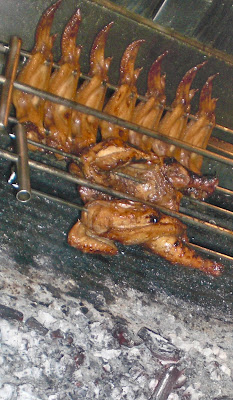In Singapore it’s not advisable to proclaim one hawker center food stall as the “best” for any particular dish. With sky-high food standards virtually wound into the DNA of most Singaporeans, it’s just too controversial an issue. Still, every now and then one stumbles upon a stall which operates on a different level than its competitors and merits bold commentary. Such places are often little-known to the uninitiated, but if you keep your food radar on when waiting in queues or sitting in crowded restaurants, you will inevitably pick up names of secret places in the furtive whispers of locals talking about great food. These are the places to find; the secret food that everyone knows about, but no one thinks anyone else does. In Singapore, however, food secrets don’t stay secret for long.
Singapore Wings
Before I go further, I should say a word about barbecued chicken wings here. They are very popular and found all across the island. But don’t expect the dripping, red bar food favorite of the US, because whether you call it the Queen City, the Nickel City, or even the City of Lights, Buffalo is still over 9000 miles away and its culinary claim to fame is nearly as distant as Singapore’s hawker centers. Here, wings are cooked in one piece – complete from soft tip to meaty shoulder. They are neither deep-fried nor tossed in cayenne sauce, and they are not served with blue cheese or celery. Instead, wrap your culinary imagination around a flame-roasted, slightly charred wing, stretched, tanned until golden and glistening with a thin, soy-based marinade cooked deep into the skin. They are moist inside, crisp outside and barbecued over an open fire. You smell them on wisps of charcoal smoke before you even reach the stall. The wafting aroma summons a primal response, causing you to stretch your neck and strain your eyes in search of the roasting delicacy you suddenly must have. That’s what wings are in Singapore. And they’re usually about three bucks for an order of three – that’s, like, nine wing sections for the US equivalent of the small latte at Starbucks. Need I say more?
The Secret Place
Barbequed chicken is all they do at Sheng Pin Xiang and they do it well. Really well. The stall is tiny, with no menu posted and not a single rating or newspaper review plastered on the wall. The inside is as austere as the outside: neat, clean and oddly uncluttered, almost as if unoccupied. But on this day the sumptuous smoke trailing from the fire said otherwise, and it pulled me like a cartoon character toward the small, open counter, behind which stood a sole cook calmly tending to a row of plump chicken wings on the steel skewer.
The wings looked sexy roasting over that perfect bit of gray and red glowing charcoal – and not those little briquettes, but earthy, blackened twigs and branches of carbonized wood. Flames danced rhythmically to the fizzing and popping of chicken fat dripping from just inches away. The meat shimmered in the heated haze as if alive and teasing my taste buds with slow-cooking aloofness; its smoky aroma broadcasting the wonders of things to come. Minutes stretched like hours as I stood, transfixed, while the meat cooked, slowly, slowly. Until at last the cook lifted them from the fire and in one smooth move slid them from the skewer to a thick wood carving board, cleaved them into sections and eased them onto my waiting plate.
The Wings
 I took my order to a nearby table and examined it like a scientist. Each wing was roasted to a deep, golden gloss with just a tinge of crispy carbon along the edges. Steam bubbled through the skin in miniscule puffs of heavenly perfume like a prelude to the first bite. A slight, sweet/tart essence from the soy mystery brew that the cook had brushed on during cooking elevated the juicy, free-range flavor to heights which, in its live state, that bird could not have flown. The citrus sparkle of the tiny calamansi lime
I took my order to a nearby table and examined it like a scientist. Each wing was roasted to a deep, golden gloss with just a tinge of crispy carbon along the edges. Steam bubbled through the skin in miniscule puffs of heavenly perfume like a prelude to the first bite. A slight, sweet/tart essence from the soy mystery brew that the cook had brushed on during cooking elevated the juicy, free-range flavor to heights which, in its live state, that bird could not have flown. The citrus sparkle of the tiny calamansi limeI squirted on, combined with a drizzle of fire-orange chili/garlic/ginger sauce for just the right touch of heat, sent me into a tailspin of gastronomic delirium.
Maybe it was the exceptional quality of chicken that made these tender wings so profoundly delicious. Or perhaps it was the charcoal, or the soy BBQ, or the fresh lime, or the chili sauce. Probably it was all of these combined. But whatever it was, I now daringly stick my neck out and proclaim the barbecued wings from this obscure little stall in the middle of a Toa Payoh hawker center as the best I have ever had. Anywhere.
So far, that is, because I will keep my ear low to the ground in hopes of catching yet more whispers of secret places to eat. But in the meantime, remember – this is my own whisper about my own secret place. So mums the word….












